 |
Vatican City
Rome, Italy
|
|
 |
Original walls: 848-852
Starfortification: 1560's
Used by: The Pope et al.
Conflicts in which it participated:
None
|
The story of forts in European cities generally begins with the phrase, the Romans were the first to build a fortification on this site. But who was responsible for Rome itself? Why that would be Romulus and Remus, who a) were suckled by a she-wolf; b) decided to build Rome on April 21, 753BC; and c) murdered each other, or at least Romulus murdered Remus, and then named the city after himself. It sure is helpful for my purposes when historical fact is so darned tidy! And it's a good thing the murder didn't happen the other way 'round, else we'd be talking about the city of Reme. |
 |
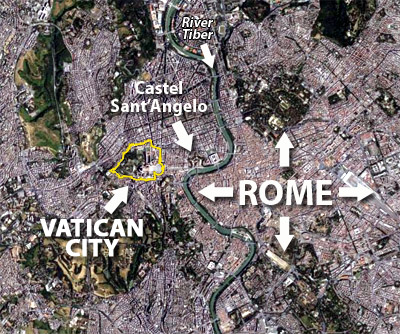
|
|
As the Roman Republic developed, the area on the west bank of the Tiber, across from the city itself, was named for nearby Vatican Hill. It was marshy land, known to the residents of Rome as a source of terrible wine, and was probably also the source of much of the malaria that forever plagued the nearby metropolis. The land was eventually "reclaimed" from the Tiber, and numerous plushy villas were built there. The third Roman Emperor, Caligula (12-41AD), built a circus for charioteers in order to entertain his mom (and it's hard to fault a guy for trying to please his mom), on the ground where the Vatican now sits. Caligula swiped an obelisk from Egypt and had it installed as a decoration at his circus: This is now the Vatican Obelisk, which adorns St. Peter's Square (which is naturally ovular in shape, as befits something called a "square").
|
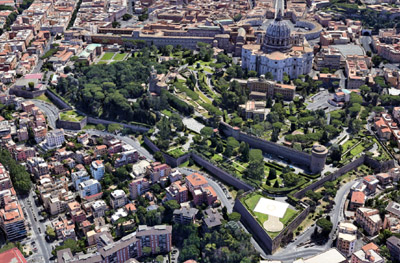 The Vatican from the west. The Vatican from the west. |
 |
Walls walls and more walls were constructed to protect the inhabitants of what was becoming the citiest city amongst cities, as Rome grew into an Empire. The Servian Wall went up in the 3rd century BC; The Aurelian Wall was built in the 3rd century AD, and is still mostly intact.
The whole Empire thing started to get a lot less fun when Constantine the Great (272-337AD) embraced Christianity. All those Christians that previous Emperors had so gleefully put to death in amusing ways were now officially-recognized martyrs, and none was more matryry than Saint Peter (d. 64AD±).
|
|
|
One of the Twelve Apostles of Jesus Christ (0-33AD), St. Peter is considered to have been the first Pope, and was executed at the behest of Roman Emperor Nero (37-68AD), because a great fire had ravaged Rome, which Nero wished to blame on the Christians, because hey, why not. "Legend" has it that St. Peter was crucified, upside-down, at or near the aforementioned Vatican Obelisk. Or maybe he died in prison as early as 44AD! Accurate records are difficult to come by from 2000+ year ago.
|
Where- or whenever St. Peter did perish, Emperor Constantine directed that a sumptuous edifice be built in Peter's honor, at the place where he (may or may not) had been crucified, at Vatican Hill: Construction of St. Peter's Basilica got underway around 320AD, and was completed in 40 years. A basilica was a Roman public building, in which court was held and business transacted: Any Roman city worthy of the name had a basilica.
The Basilica of Our Present Interest became one of vast importance to Rome and Christianity in general, as Papal Coronations were held therein, and none other than Charlamagne (747-814), Holy Roman Emperor Numero Uno, was crowned at St. Peter's Basilica in 800.
|
 |
The original St. Peter's Basilica, "about the year MCCCCL," which would be 1450 for those of us who don't speak Roman. There's that Vatican Obelisk, ever-present, center left! |
|
Which is all well and good, but what happens when you build an Empire, whose capital city is filled with riches beyond anyone's wildest imaginations, and then allow that Empire to lose its military edge over all of its neighbors? Why, those neighbors come over and loot the snot out of that city of course. Repeatedly. In 846 the Saracens (as Muslims from Arabia, Turkey and/or Iran were known to those in the west), attacked Rome, lookin' for plunder. The Aurelian Walls kept them out of the main city, but the Vatican area was outside those walls, and St. Peter's Basilica was comprehensively sacked and badly damaged.
|
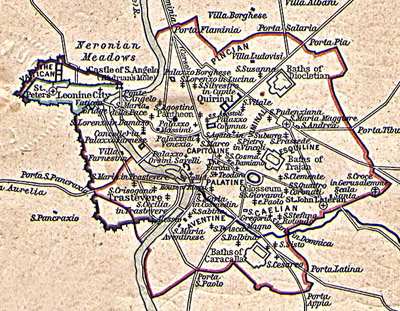 Rome's medieval walls, as presented in a 1923 map. The walled Vatican, or Leonine City as it was initially known, is visible dangling out there at the upper left. |
 |
Pope Leo III (d. 816) had attempted to build walls around the Basilica, but "city disturbances" prevented this project from getting fully underway, and he just wasn't Leo enough to get the job done...but Pope Leo IV (790-855) had more than enough Leo mojo to make it happen. Following the Saracen incident, the first thing the IV saw to was the replenishment of the Basilica's 206 lb. gold altar (studded with precious jewels, natch), and the second was the proper walling-up of what became known as the Leonine City.
From 848 to 852 Leo's estate workers, local folks plucked from the countryside and Saracen prisoners built a three-kilometer wall of tuff and tile around Vatican Hill. 44 towers, sited at bowshot intervals, dotted the wall. |
|
|
Anchoring this new wall to the northeast was Hadrian's Mausoleum. Chiefly remembered by the English-speaking world as the fellow who built the wall defining the northern limit of Britannia in the second century AD and then creatively named it after himself, Roman Emperor Hadrian (76-138) was such a swell guy that a mausoleum (known in this case as a mole) was built for him upon his demise, just across the Tiber from Rome. Hadrian's ashes were majestically entombed therein, which seemed like such a cool idea that the following eight Roman Emperors had their ashes parked in this tomb as well. Sadly, these holiest of ashes were scattered by Visigoths when Rome was sacked in 410.
|
A mausoleum would usually be of little interest to we the starfort elite, but like a lowly caterpillar metamorphing into a beautiful butterfly, Hadrian's tomb magically became Castel Sant'Angelo in the 14th century, and received the full starfort treatment in the 16th century. Leo's walls were put to the test in the 11th century, when Pope Gregory VI (1015-1085) was surprised to find himself besieged by the forces of Henry IV (1050-1106), King of Germany, Italy and Burgundy. Gregory had continually refused to crown Henry as Holy Roman Emperor, excommunicating him instead, twice. The Pope huddled down in Castel Sant'Angelo for a while, but was eventually pried out and exiled. The walls did keep Henry & co. at bay for a little while.
|
 |
The present visage of Hadrian's Mausoleum, also known as Castel Sant'Angelo, anchoring a corner of the Vatican. |
|
We could of course talk for ages of the doings of Popes, Antipopes and Holy Roman Emperors, but as we are all eager to learn why and when the Vatican became a starfort, we will fast-forward several centuries to 1527, when mutinous troops of Holy Roman Emperor Charles V (1500-1558) entered, and pillaged, Rome. They went after Pope Clement VII (1478-1534) whom, thanks to a suicidal rearguard action fought by his Swiss Guard, managed to make it to Castel Sant'Angelo. Shortly thereafter he surrendered himself, agreeing to pay an exorbitant ransom for his freedom, but was held captive in his Castel for the next six months while events played out. Clement VII eventually managed to slip away disguised as a lowly person unworthy of ransom, but the experience had been a universally negative one for the Pope, not to mention Rome as a whole, which had been decimated. While the Leonine wall had served as a valid defense of the Vatican for half a millenium, modernization was plainly in order.
40 years pass. Pope Pius IV (1499-1565)'s real name was Giovanni Angelo Medici, and was a product of the hugely influential House of Medici whom, among other stellar accomplishments including furthering the causes of art, science and generally enriching themselves, were the driving force behind the initial development of the starfort.
As major landholders in northern Italy, the Medici were particularly threatened by the invasion of Italy by France's King Charles VIII (1470-1498) in 1494, at the head of an army of 25,000. Trailing some distance behind Charles' horse was an amalgamation of what passed for field guns at the end of the 15th century: Cumbersome, maddeningly slow to reload and vastly inaccurate as these cannon may have been, they were castle killers, castles not being the nimblest of prey. To protect their holdings, the Medici spared no expense in employing Italy's best military engineers, tasking them with coming up with a reliable defense against this new, deafeningly loud threat. The result of this Medician effort was the starfort.
|
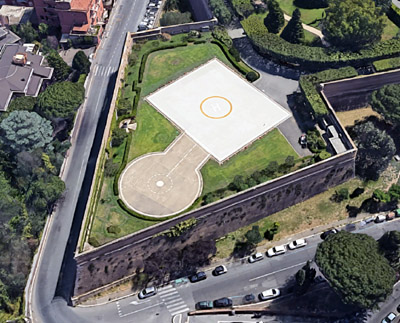 A closer look at the Vatican's westernmost bastion, home of the Holy Heliport! Which probably isn't really what it's called, but it should be. |
 |
Would starforts have been born, had the Medici not contracted for their creation? Surely something similar would have come along, but since the rest of Europe rushed to copy the Trace Italienne, as this style of fortification was initially known, whatever pseudo-starfort did replace it in this theoretical timeline would probably have looked much different than the distinctive starry shape we know and love.
Accordingly, it makes total sense that it would be a Medician Pope who was responsible for the Vatican's starfortification. Sadly, the exact dates of this fortification aren't jumping out at me in my usual halfassed research, but Pius VI's motivations seem pretty clear: Prevention of another looting spree as had occurred in 1527 was certainly one motivation, but there were also closer, more well-dressed threats.
|
|
|
Historically, Italian kings had an interest in what the Vatican had, which was a great deal of wealth and power: In addition to their duties as the head Christiandom, beginning in the 8th century Popes were also the secular rulers of the Papal States. Often donations from Holy Roman Emperors, these lands eventually amounted to a good chunk of central- and northern Italy, and were the source of a great deal of the Vatican's wealth: Wealth that an Italian king would have been more than happy to nab.
Additionally, fortifications look cool. And while this may sound like a puerile statement (which it is), the demonstrable security and solidity represented by such walls would have been an impression any Pope would wish to make. So while there doesn't seem to have been any immediate threat to the Vatican in the mid-16th century, one imagines that Pope Pius VI, who enjoyed having stuff built anyway, found the starfortification of the Vatican to be a worthwhile endeavor.
Was Fortress Vatican armed? Is a starfort even a starfort if it doesn't mount any guns? Again, history seems to have little interest in this period of the Vatican's development, so I don't have these answers...but this is definitely a unique circumstance, and a Papal mindset of fortification si, armaments no, doesn't seem too far-fetched. The Papal States did field their own army, however, so there were dudes around who likely know one end of a cannon from the other.
|
As has been repeatedly stated in the history of starforts at Starforts.com, Napoleon (1769-1821) completely effed up everything in Europe. But in Italy's case, the Napoleonic Wars (1803-1805) and the preceding French Revolutionary Wars ended up making it possible for Italian unification in the 1860's.
For centuries Austria, the Habsburgs, the Holy Roman Empire and the frequently-mentioned-on-this-page Pope had controlled most of Italy, but Napoleon enthusiastically knocked over that particular house of cards...which the Congress of Vienna daintily reassembled in 1814, trying to force the world back into what it had been prior to the Tiny Tyrant's European rampage.
|
 |
I'm usually dismissive about over-decoration of starforts, but we're talking the Vatican here. |
|
But in the interim, Italians had been infected with the dreadful disease of nationalism. Rebellions in the 1820's and 30's started the unification ball rolling, and by 1871 the Papal State was no more: Rome was the capital of the new kingdom of Italy, and Pope Pius IX (1792-1878) crossed his arms and pouted in the Vatican until 1929.
|
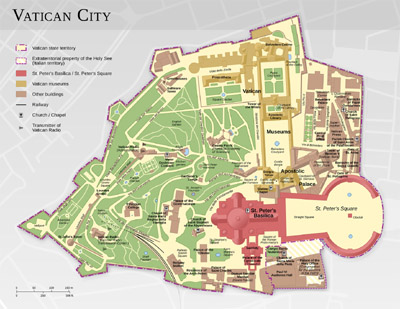 The Vatican today. At the lower left, one can see remnants of the Leonine Wall inside Pius IV's starfort walls. |
 |
Okay not really. Pius IX and the following four Popes were self-incarcerated "prisoners in the Vatican," as the Italian Law of Guarantees (1871) declared the Pope to be a subject of Italy, not an independent sovereign. Pius IX and his four successors rejected this notion, and refused to leave the Vatican. In 1929 Italy finally caved and said all right, you're a sovereign state. Now are you happy?! Yes, the Pope was happy, or at least as happy as he was going to get under the circumstances.
The glorious unification of Italy brought with it an immediate threat from France, which had been semi-guaranteeing Papal sovereignty prior to the outbreak of the Franco-Prussian War (1870-1871). French troops were withdrawn from Rome in order to lose to Prussia, and wouldn't you know it, the Italians took advantage of the absence of French troops and claimed Rome as their own. |
|
|
Though Napoleon III (1808-1873) was a captive of the Prussians and France was essentially rudderless, there was an Italian fear that vast Napoleonic columns would march on Rome, bent on restoring the old, Papal order. A new enthusiasm for fortification gripped the city authorities, but the ever-increasing range and accuracy of artillery had rendered the starfort obsolete. In 1877 ground was broken for the late-19th-century European version of the starfort to defend Rome: A ring of artillery forts. That subject is beyond the scope of a page about the Vatican, however, so you can learn more about it at Starforts.com's Fortifications of Rome page. Today, though being surrounded by world-class starfortery, it's easier to get into the Vatican than a major American airport. Pass through a metal detector, show some ID (reportedly a library card will work), and pow, you're hangin' with the Pope. |
|
|
|
|
|
 |




